2001 四川考研英语二真题及答案
Section 1 Use of Eninglish
Directions :
Millions of Americans and foreigners see GI.Joe as a mindless war toy ,the symbol
of American military adventurism, but that’s not how it used to be .To the men and
women who 1 )in World War II and the people they liberated ,the GI.was the 2) man
grown into hero ,the pool farm kid torn away from his home ,the guy who 3) all the
burdens of battle ,who slept in cold foxholes,who went without the 4) of food and
shelter ,who stuck it out and drove back the Nazi reign of murder .this was not a
volunteer soldier ,not someone well paid ,5) an average guy ,up 6 )the best
trained ,best equipped ,fiercest ,most brutal enemies seen in centuries.
His name is not much.GI. is just a military abbreviation 7) Government Issue ,and
it was on all of the article 8) to soldiers .And Joe? A common name for a guy who
never 9) it to the top .Joe Blow ,Joe Magrac …a working class name.The United States
has 10) had a president or vicepresident or secretary of state Joe.
GI .joe had a (11)career fighting German ,Japanese , and Korean troops . He appers
as a character ,or a (12 ) of american personalities, in the 1945 movie The Story
of GI. Joe, based on the last days of war correspondent Ernie Pyle. Some of the
soldiers Pyle(13)portrayde themselves in the film. Pyle was famous for covering the
(14)side of the warl, writing about the dirt-snow -and-mud soldiers, not how many
miles were(15)or what towns were captured or liberated, His reports(16)the “willie”
cartoons of famed Stars and Stripes artist Bill Maulden. Both men(17)the dirt and
exhaustion of war, the (18)of civilization that the soldiers shared with each other
and the civilians: coffee, tobacco, whiskey, shelter, sleep. (19)Egypt, France, and
a dozen more countries, G.I. Joe was any American soldier,(20)the most important
person in their lives.
1.[A] performed [B]served [C]rebelled [D]betrayed
2.[A] actual [B]common [C]special [D]normal
3.[A]bore [B]cased [C]removed [D]loaded
4.[A]necessities [B]facilitice [C]commodities [D]propertoes
5.[A]and [B]nor [C]but [D]hence
6.[A]for [B]into [C] form [D]against
7.[A]meaning [B]implying [C]symbolizing [D]claiming
8.[A]handed out [B]turn over [C]brought back [D]passed down
9.[A]pushed [B]got [C]made [D]managed
10.[A]ever [B]never [C]either [D]neither
11.[A]disguised [B]disturbed [C]disputed [D]distinguished
�
12.[A]company [B]collection [C]community [D]colony
13.[A]employed [B]appointed [C]interviewed [D]questioned
14.[A]ethical [B]military [C]political [D]human
15.[A]ruined [B]commuted [C]patrolled [D]gained
16.[A]paralleled [B]counteracted [C]duplicated [D]contradicted
17.[A]neglected [B]avoided [C]emphasized [D]admired
18.[A]stages [B]illusions [C]fragments [D]advancea
19.[A]With [B]To [C]Among [D]Beyond
20.[A]on the contrary [B] by this means [C]from the outset [D]at that point
Section II Resdiong Comprehension
Part A
Directions:
Read the following four texts. answer the question after each text by choosing
A,B,C or D. Mark your answers on ANSWER SHEET 1.(40 points)
Text 1
Homework has never been terribly popular with students and even many parents,
but in recent years it has been particularly scorned. School districts across the
country, most recently Los Angeles Unified, are revising their thinking on his
educational ritual. Unfortunately, L.A. Unified has produced an inflexible policy
which mandates that with the exception of some advanced courses, homework may no
longer count for more than 10% of a student’s academic grade.
This rule is meant to address the difficulty that students from impoverished
or chaotic homes might have in completing their homework. But the policy is unclear
and contradictory. Certainly, no homework should be assigned that students cannot
do without expensive equipment. But if the district is essentially giving a pass
to students who do not do their homework because of complicated family lives, it
is going riskily close to the implication that standards need to be lowered for poor
children.
District administrators say that homework will still be a pat of schooling:
teachers are allowed to assign as much of it as they want. But with homework counting
for no more than 10% of their grades, students can easily skip half their homework
and see vey little difference on their report cards. Some students might do well
on state tests without completing their homework, but what about the students who
performed well on the tests and did their homework? It is quite possible that the
homework helped. Yet rather than empowering teachers to find what works best for
their students, the polic y imposes a flat, across-the-board rule.
�
At the same time, the policy addresses none of the truly thorny questions about
homework. If the district finds homework to be unimportant to its students’ academic
achievement, it should move to reduce or eliminate the assignments, not make them
count for almost nothing. Conversely, if homework does nothing to ensure that the
homework students are not assigning more than they are willing to review and correct.
The homework rules should be put on hold while the school board, which is
responsible for setting educational policy, looks into the matter and conducts
public hearings. It is not too late for L.A. Unified to do homework right.
21.It is implied in paragraph 1 that nowadays homework_____.
[A] is receiving more criticism
[B]is no longer an educational ritual
[C]is not required for advanced courses
[D]is gaining more preferences
22.L.A.Unified has made the rule about homework mainly because poor
students_____.
[A]tend to have moderate expectations for their education
[B]have asked for a different educational standard
[C]may have problems finishing their homework
[D]have voiced their complaints about homework
23.According to Paragraph 3,one problem with the policy is that it may____.
[A]discourage students from doing homework
[B]result in students' indifference to their report cards
[C]undermine the authority of state tests
[D]restrict teachers' power in education
24. As mentioned in Paragraph 4, a key question unanswered about homework is
whether______. [A] it should be eliminated
[B]it counts much in schooling
[C]it places extra burdens on teachers
[D]it is important for grades
25.A suitable title for this text could be______.
[A]Wrong Interpretation of an Educational Policy
[B]A Welcomed Policy for Poor Students
[C]Thorny Questions about Homework
[D]A Faulty Approach to Homework
Text2
�
Pretty in pink: adult women do not rememer being so obsessed with the colour,
yet it is pervasive in our young girls’ lives. Tt is not that pink is intrinsically
bad, but it is such a tiny slice of the rainbow and, though it may celebrate girlhood
in one way, it also repeatedly and firmly fuses girls’ identity to appearance. Then
it presents that connection, even among two-year-olds, between girls as not only
innocent but as evidence of innocence. Looking around, I despaired at the singular
lack of imagination about girls’ lives and interests.
Girls’ attraction to pink may seem unavoidable, somehow encoded in their DNA,
but according to Jo Paoletti, an associate professor of American Studies, it is not.
Children were not colour-coded at all until the early 20th century: in the era before
domestic washing machines all babies wore white as a practical matter, since the
only way of getting clothes clean was to boil them. What’s more, both boys and girls
wore what were thought of as gender-neutral dresses.When nursery colours were
introduced, pink was actually considered the more masculine colour, a pastel version
of red, which was associated with strength. Blue, with its intimations of the Virgin
Mary, constancy and faithfulness, symbolised femininity. It was not until the
mid-1980s, when amplifying age and sex differences became a dominant children’s
marketing strategy, that pink fully came into its own, when it began to seem
inherently attractive to girls, part of what defined them as female, at least for
the first few critical years.
I had not realised how profoundly marketing trends dictated our perception of
what is natural to kins, including our core beliefs about their psychological
development. Take the toddler. I assumed that phase was something experts developed
after years of research into children’s behaviour: wrong. Turns out, acdording to
Daniel Cook, a historian of childhood consumerism, it was popularised as a marketing
trick by clothing manufacrurers in the 1930s.
Trade publications counselled department stores that, in order to increase sales,
they should create a “third stepping stone” between infant wear and older kids’
clothes. Tt was only after “toddler”became a common shoppers’ term that it evolved
into a broadly accepted developmental stage. Splitting kids, or adults,into
ever-tinier categories has proved a sure-fire way to boost profits. And one of the
easiest ways to segment a market is to magnify gender differences - or invent them
where they did not previously exist.
26.By saying "it is...the rainbow"(Line 3, Para.1),the author means pink______.
[A]should not be the sole representation of girlhood
[B]should not be associated with girls' innocence
[C]cannot explain girls' lack of imagination
[D]cannot influence girls' lives and interests
27.According to Paragraph 2, which of the following is true of colours?
�
[A]Colours are encoded in girls' DNA.
[B]Blue used to be regarded as the colour for girls.
[C]Pink used to be a neutral colour in symbolising genders.
[D]White is prefered by babies.
28.The author suggests that our perception of children's psychological
development was much influenced by_____.
[A]the marketing of products for children
[B]the observation of children's nature
[C]researches into children's behavior
[D]studies of childhood consumption
29.We may learn from Paragraph 4 that department stores were advised to_____.
[A]focus on infant wear and older kids' clothes
[B]attach equal importance to different genders
[C]classify consumers into smaller groups
[D]create some common shoppers' terms
30.It can be concluded that girls' attraction to pink seems to be____.
[A] clearly explained by their inborn tendency
[B]fully understood by clothing manufacturers
[C] mainly imposed by profit-driven businessmen
[D]well interpreted by psychological experts
Text 3
In 2010. a federal judge shook America's biotech industry to its core. Companies
had won patents for isolated DNA for decades-by 2005 some 20% of human genes were
parented. But in March 2010 a judge ruled that genes were unpatentable. Executives
were violently agitated. The Biotechnology Industry Organisation (BIO), a trade
group, assured members that this was just a “preliminary step” in a longer battle.
On July 29th they were relieved, at least temporarily. A federal appeals court
overturned the prior decision, ruling that Myriad Genetics could indeed holb patents
to two genss that help forecast a woman's risk of breast cancer. The chief executive
of Myriad, a company in Utah,said the ruling was a blessing to firms and patients
alike.
But as companies continue their attempts at personalised medicine, the courts
will remain rather busy. The Myriad case itself is probably not over Critics make
three main arguments against gene patents: a gene is a product of nature, so it may
not be patented; gene patents suppress innovation rather than reward it; and patents'
monopolies restrict access to genetic tests such as Myriad's. A growing number seem
to agree.Last year a federal task-force urged reform for patents related to genetic
�
tests. In October the Department of Justice filed a brief in the Myriad case, arguing
that an isolated DNA molecule “is no less a product of nature... than are cotton
fibres that have been separated from cotton seeds. ”
Despite the appeals court's decision, big questions remain unanswered. For
example, it is unclear whether the sequencing of a whole genome violates the patents
of indivi dual genes within it. The case may yet reach the Supreme Court.
AS the industry advances ,however,other suits may have an even greater
impact.companies are unlikely to file many more patents for human DNA molecules-most
are already patented or in
the public domain .firms are now studying how genes
intcract,looking for correlations that might be used to determine the causes of
disease or predict a drug ’ s efficacy,companies are eager to win patents for
‘connecting the dits’,expaains hans sauer,alawyer for the BIO.
Their success may be determined by a suit related to this issue, brought by the
Mayo Clinic, which the Supreme Court will hear in its next term. The BIO rtcently
held a convention which included seddions to coach lawyers on the shifting landscape
for patents. Each meeting was packed.
31.it canbe learned from paragraph I that the biotech companies would like-----
A.their executives to be active
B.judges to rule out gene patenting
C.genes to be patcntablc
D.the BIO to issue a warning
32.those who are against gene patents believe that----
A.genetic tests are not reliable
B.only man-made products are patentable
C.patents on
D.courts should restrict access to gene tic tests
genes depend much on innovatiaon
33.according to hans sauer ,companies are eager to win patents for----
A.establishing disease comelations
B.discovering gene interactions
C.drawing pictures of genes
D.identifying human DNA
34.By saying “each meeting was packed”(line4,para6)the author means that -----
A.the supreme court was authoritative
B.the BIO was a powerful organization
C.gene patenting was a great concern
D.lawyers were keen to attend conventiongs
�
35.generally speaking ,the author’s attitude toward gene patenting is----
A.critical
B.supportive
C.scornful
D.objective
Text 4
The great recession may be over, but this era of high joblessness is probably
beginning. Before it ends,
it will likely change the life course and character of a generation of young
adults. And ultimately, it is likely to reshape our politics,our culture, and the
character of our society for years.
No one tries harder than the jobless to find silver linings in this national
economic disaster. Many said that unemployment, while extremely painful, had
improved them in some ways; they had become less materialistic and more financially
prudent; they were more aware of the struggles of others. In limited respects,
perhaps the recession will leave society better off. At the very least, it has awoken
us from our national fever dream of easy riches and bigger houses, and put a necessary
end to an era of reckless personal spending.
But for the most part, these benefits seem thin, uncertain, and far off. In The
Moral Consequences of Economic Growth, the economic historian Benjamin Friedman
argues that both inside and outside the U.S. ,lengthy periods of economic stagnation
or decline have almost always left society more mean-spirited and less inclusive,
and have usually stopped or reversed the advance of rights and freedoms.
Anti-immigrant sentiment typically increases, as does conflict between races and
classes.
Income inequality usually falls during a recession, but it has not shrunk in
this one,. Indeed, this period of economic weakness may reinforce class divides,
and decrease opportunities to cross them--- especially for young people. The
research of Till Von Wachter, the economist in Columbia University, suggests that
not all people graduating into a recession see their life chances dimmed: those with
degrees from elite universities catch up fairly quickly to where they otherwise would
have been if they had graduated in better times; it is the masses beneath them that
are left behind.
In the internet age, it is particularly easy to see the resentment that has always
been hidden winthin American society. More difficult, in the moment , is discerning
precisely how these lean times are affecting society’s character. In many respects,
the U.S. was more socially tolerant entering this resession than at any time in its
�
history, and a variety of national polls on social conflict since then have shown
mixed results. We will have to wait and see exactly how these hard times will reshape
our social fabric. But they certainly it, and all the more so the longer they extend.
36.By saying “to find silver linings”(Line 1,Para.2)the author suggest that
the jobless try to___.
[A]seek subsidies from the govemment
[B]explore reasons for the unermployment
[C]make profits from the troubled economy
[D]look on the bright side of the recession
37.According to Paragraph 2,the recession has made people_____.
[A]realize the national dream
[B]struggle against each other
[C]challenge their lifestyle
[D]reconsider their lifestyle
38.Benjamin Friedman believe that economic recessions may_____.
[A]impose a heavier burden on immigrants
[B]bring out more evils of human nature
[C]Promote the advance of rights and freedoms
[D]ease conflicts between races and classes
39.The research of Till Von Wachther suggests that in recession graduates from
elite universities tend to _____.
[A]lag behind the others due to decreased opportunities
[B]catch up quickly with experienced employees
[C]see their life chances as dimmed as the others’
[D]recover more quickly than the others
40.The author thinks that the influence of hard times on society is____.
[A]certain
[B]positive
[C]trivial
[D]destructive
Part B
Directions:
Read the following text and answer the questions by finding information from
the left column that corresponds to each of the marked details given in the right
column. There are two extra choices in the right column. Mark you r answers on ANSWER
SHEERT 1.(10 points)
�
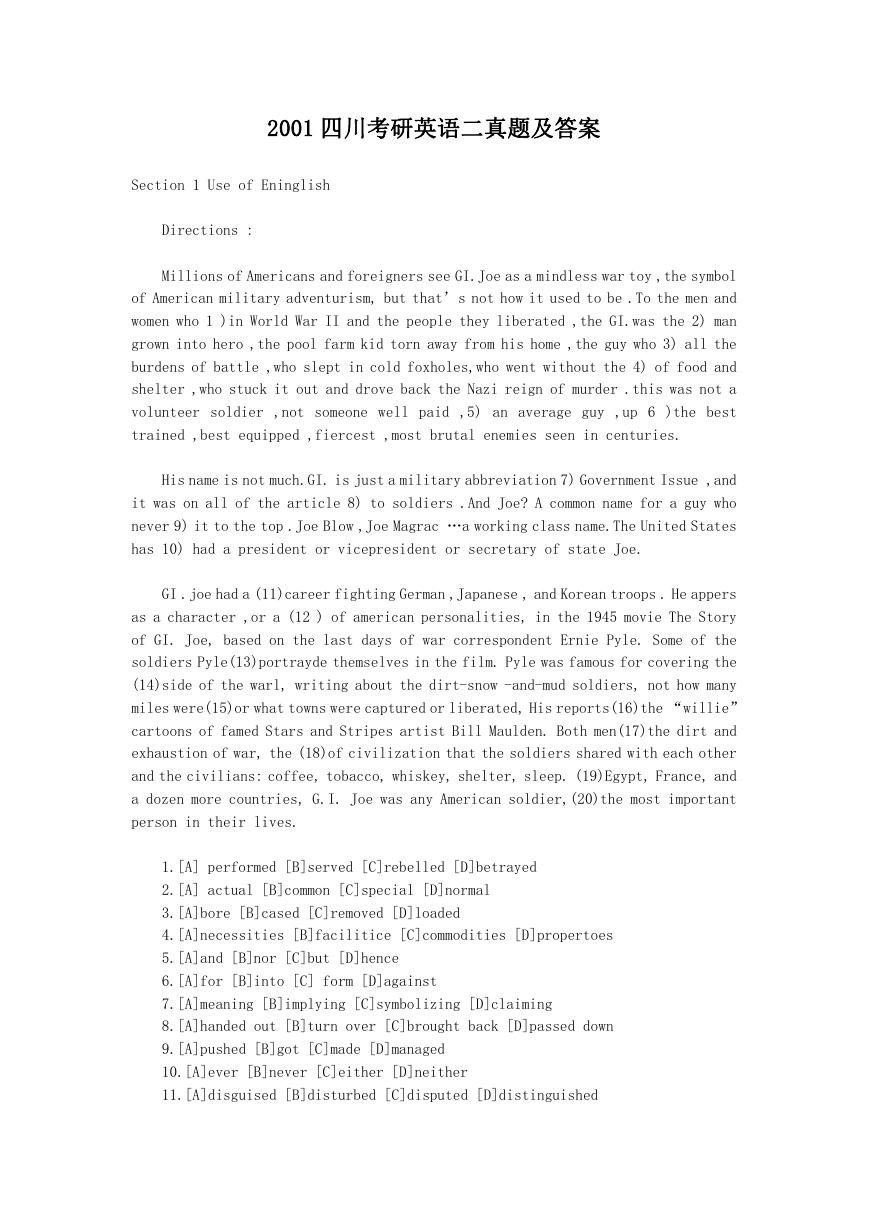
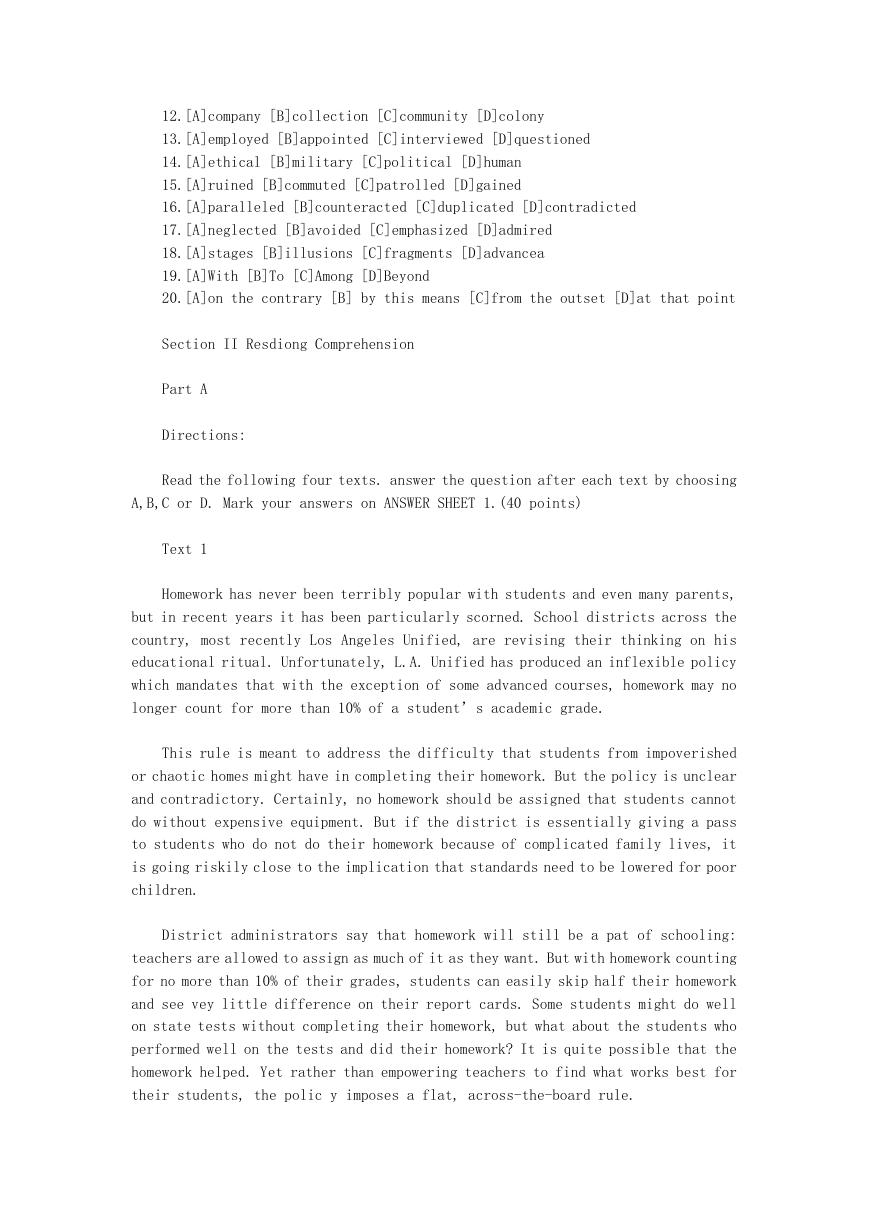

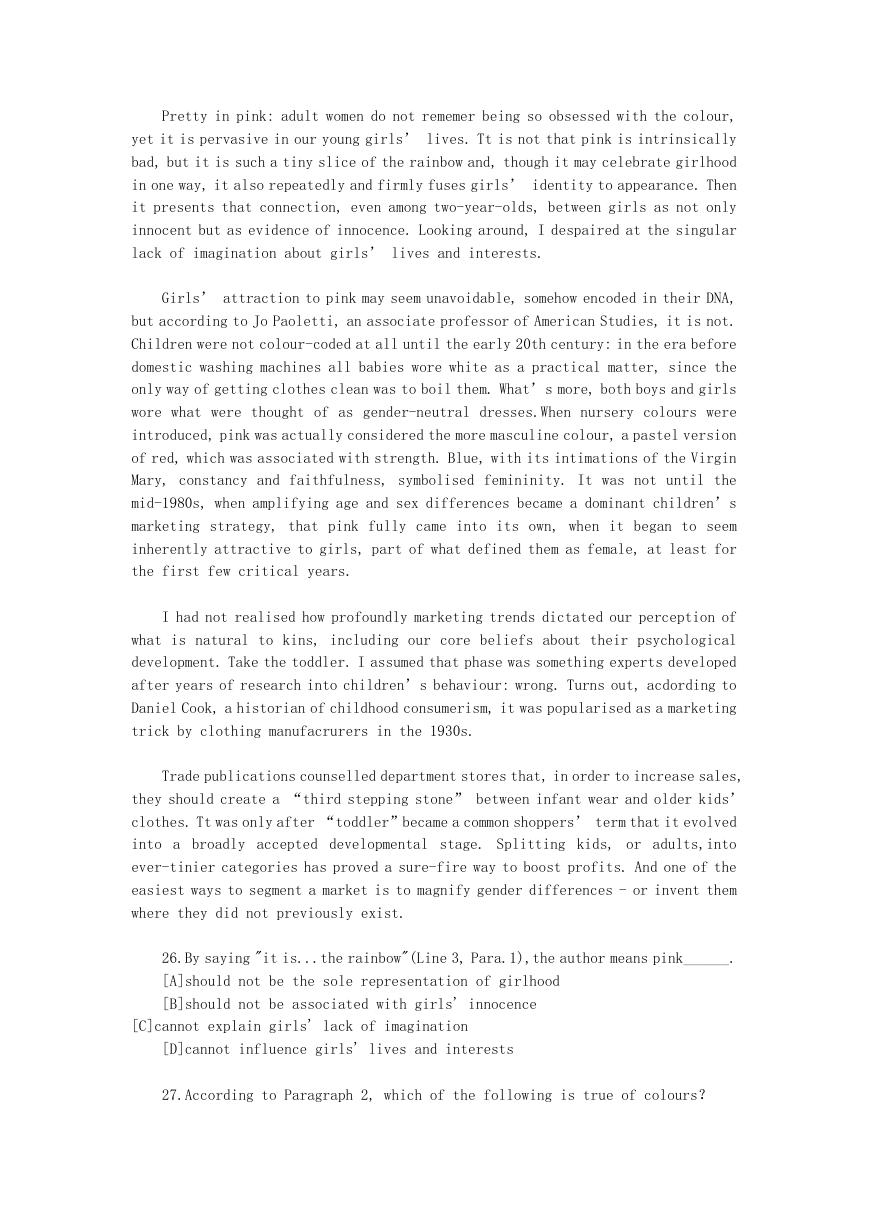
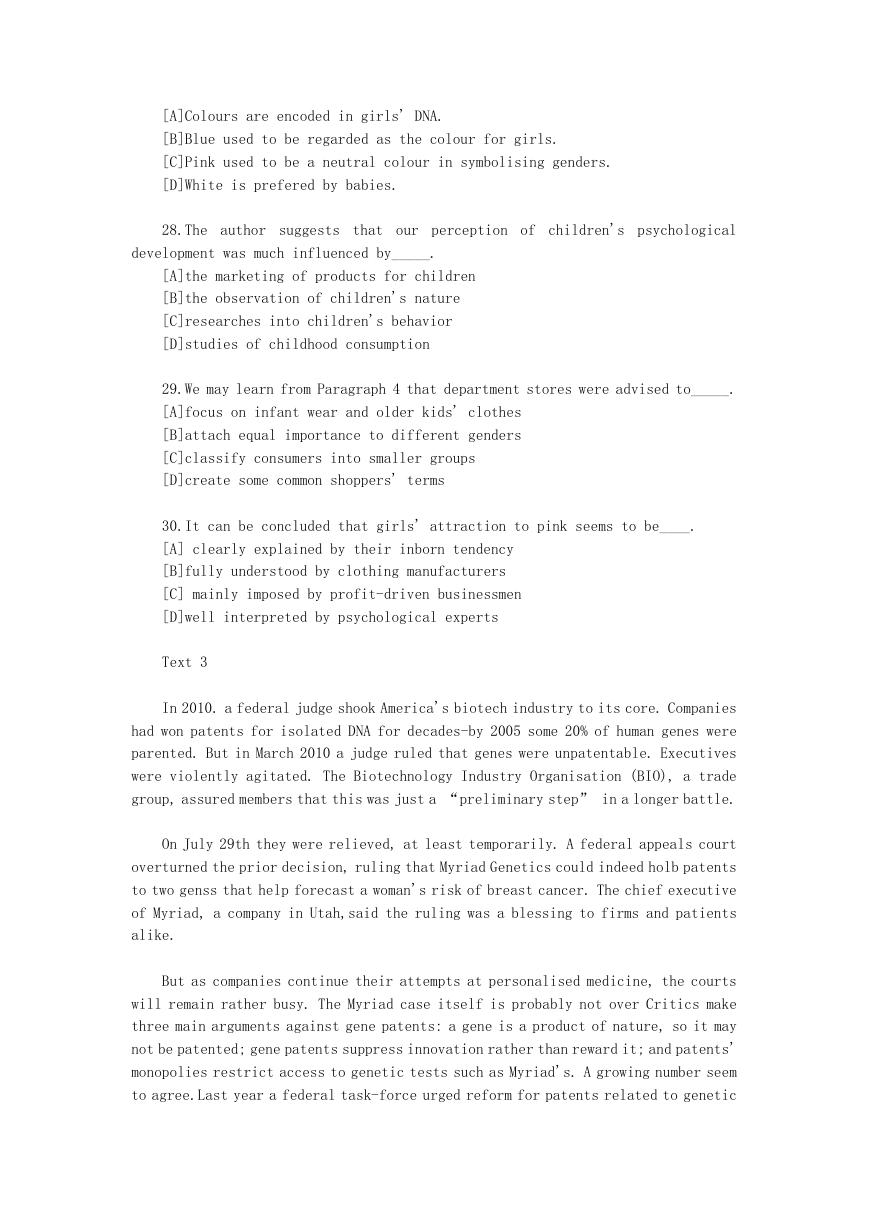
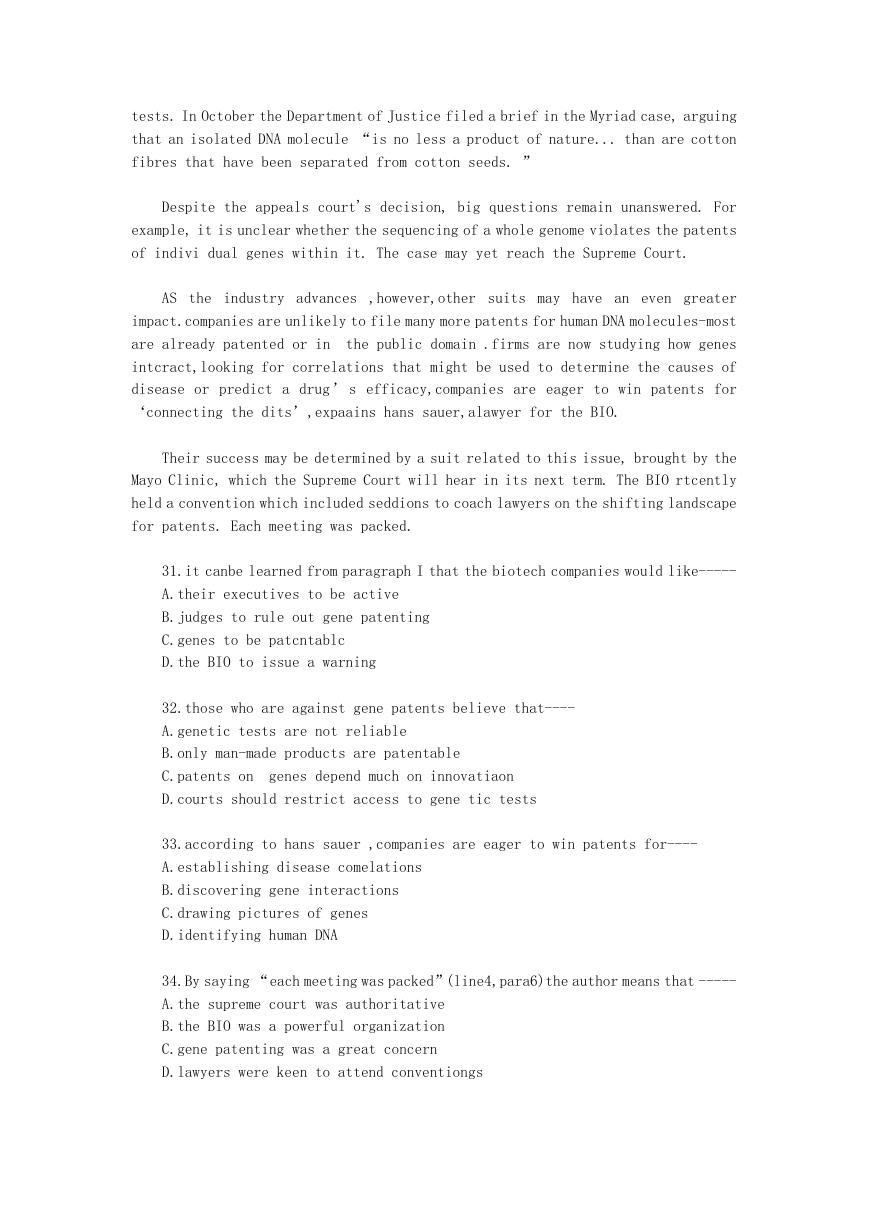
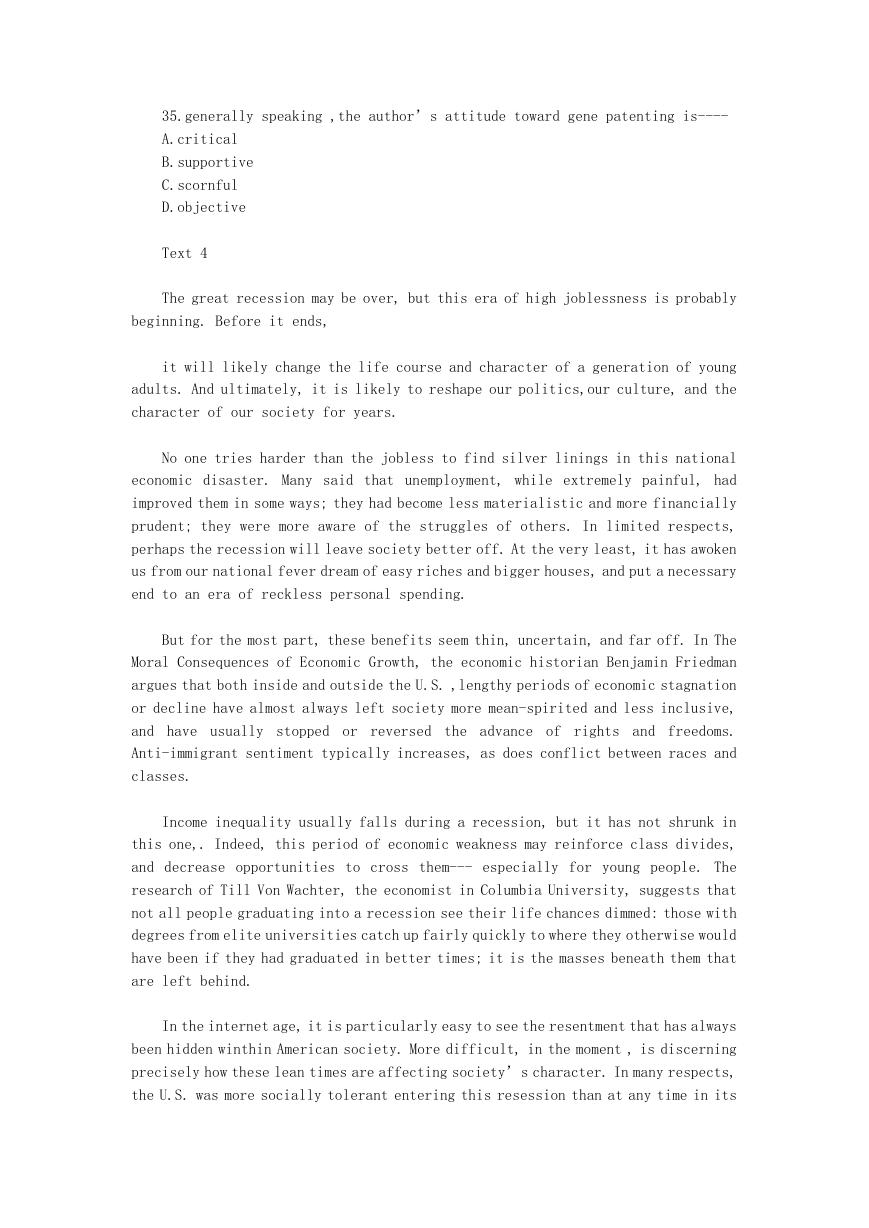









 2023年江西萍乡中考道德与法治真题及答案.doc
2023年江西萍乡中考道德与法治真题及答案.doc 2012年重庆南川中考生物真题及答案.doc
2012年重庆南川中考生物真题及答案.doc 2013年江西师范大学地理学综合及文艺理论基础考研真题.doc
2013年江西师范大学地理学综合及文艺理论基础考研真题.doc 2020年四川甘孜小升初语文真题及答案I卷.doc
2020年四川甘孜小升初语文真题及答案I卷.doc 2020年注册岩土工程师专业基础考试真题及答案.doc
2020年注册岩土工程师专业基础考试真题及答案.doc 2023-2024学年福建省厦门市九年级上学期数学月考试题及答案.doc
2023-2024学年福建省厦门市九年级上学期数学月考试题及答案.doc 2021-2022学年辽宁省沈阳市大东区九年级上学期语文期末试题及答案.doc
2021-2022学年辽宁省沈阳市大东区九年级上学期语文期末试题及答案.doc 2022-2023学年北京东城区初三第一学期物理期末试卷及答案.doc
2022-2023学年北京东城区初三第一学期物理期末试卷及答案.doc 2018上半年江西教师资格初中地理学科知识与教学能力真题及答案.doc
2018上半年江西教师资格初中地理学科知识与教学能力真题及答案.doc 2012年河北国家公务员申论考试真题及答案-省级.doc
2012年河北国家公务员申论考试真题及答案-省级.doc 2020-2021学年江苏省扬州市江都区邵樊片九年级上学期数学第一次质量检测试题及答案.doc
2020-2021学年江苏省扬州市江都区邵樊片九年级上学期数学第一次质量检测试题及答案.doc 2022下半年黑龙江教师资格证中学综合素质真题及答案.doc
2022下半年黑龙江教师资格证中学综合素质真题及答案.doc